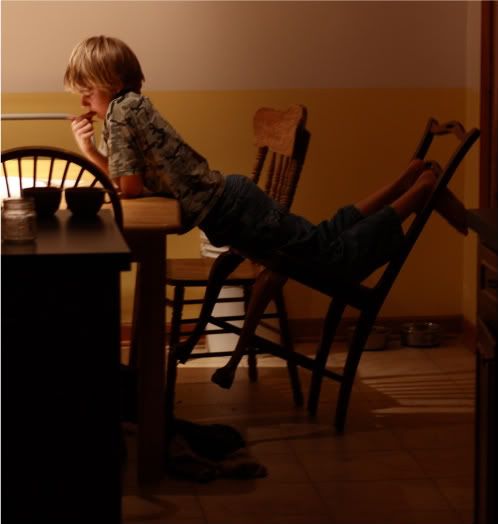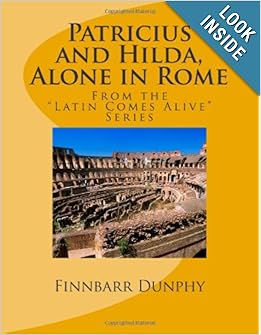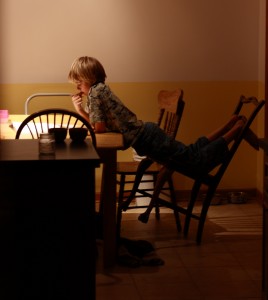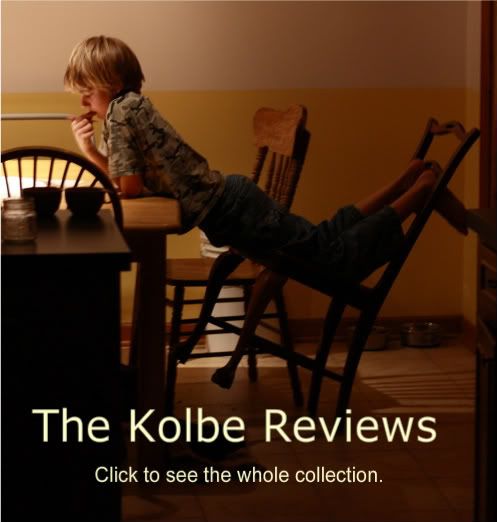
I’ve gotten a few requests for updates, so it’s about time. One mega-post to cover four kids, all subjects. Here’s what we’ve got going for 2013-2014, and how we like it so far. Quick version: Two bigs are in 8th and 6th, enrolled with Kolbe but doing varying amounts of the program. Littles (4th & 2nd) are freelancing with a variety of stuff, increasingly workbook-y, because that’s my life.
Long Version
Grammar: Mr. Boy is doing 8th grade per Kolbe, Voyages in English (now called “Lepanto English” I believe.) Grammar nerd that I am, I still like it.
6th Grader is sitting through a year of Classical Conversation’s “Essentials” course, which is an exacting (some would say: exasperating) tour of grammar and heavy-handed editing. It suits her fine, in an anything-that-doesn’t-kill-you way, but we’ll be back to Voyages next year. NB: Classical Conversations has a strongly, strongly protestant world view. Just sayin’. FYI, I’m happy we are doing the class, it serves our purposes.
4th and 2nd Grader are doing the Language of God workbooks from Catholic Heritage Curriculum. They don’t like them, because they don’t like anything in the genre, but I do. Heavy on the Catholic-ness, makes Voyages/Lepanto look like secular city. I’m good with that.

Vocabulary / Spelling: 8th & 6th grader continue with Kolbe’s recommended vocabulary book. I remain very happy with it, and they seem to do pretty well and not mind it. Littles are using CHC’s Speller, same comment as per above. The CHC 4th grade program is a much lighter program than the Sadlier-Oxford Vocabulary.
For phonics / word study, all three girls are going with the Kolbe-default, MCP plaid. I continue to like it very much. We skip some of the exercises that aren’t my favorite though, usually the “write a letter to your friend . . . ” ones. We’re in it for the phonics.
Geography: Kolbe changed their geography book, and I haven’t seen the new one. I like the old one so much I bought the levels I didn’t have on clearance from the friendly Kolbe bookstore lady. But we’re in an off-year for geography, too much going on elsewhere. We’ll be back at it next year.
History: I’m sticking with my program of keeping all kids on the same general history topic. They are anchored to Mr. Boy, who is in 8th grade and finishing out with American this year, and then he’ll be back to Greek next year. Doing the four year cycle of Greek-Roman-Middle-Modern works pretty well for us. We aren’t the kind of people who would fail to study Africa and Asia just because no one made us. So, what it looks like textbook-wise:

8th Grader is doing Christ in the Americas, per the Kolbe plans. He complains it’s all pro-Catholic agitiprop, but I like that. (It is a survey of American History, but with a strongly Catholic orientation.) He did Christ the King Lord of History last year, same complaints / parental approval. Tip: Kolbe publishes two sets of course plans for these — one for middle school, one for high school. If you aren’t sure what to choose, you can request both (if you’re enrolled), then take a look and see which is a better fit.

6th Grader is doing CHC’s From Sea to Shining Sea. Alert: There are other US History books with the same general title. Make sure you pick the correct one. We like it very much — colorful, informative, readable, happily Catholic. She likes this better than last year’s Founders of Freedom, which was a little too vintage black-n-white for her tastes. Since she has a lot of work in other subjects, I’m just having her read the text (we did not purchase the workbook, teacher’s manual, etc.) and do one project a quarter for tangible work for the portfolio.
I was stymied on where to find suitable US History texts for the littles until I got to look through Seton’s table at the IHM Conference this summer. My 4th grader is reading through both books 4 & 5 this year (Seton divides US history over two years), and the 2nd grader is reading book 1. They are doing personal-choice reading to go with, heavy on American Girls novels and the like.
Religion. I love Faith and Life. Very happy with what Kolbe does there. All four kids are on the program. And I don’t care what anyone says, the Baltimore Catechism is one handy book. I approve. We fill out those two with lives of saints in literature or normal life.
Bible History. Kolbe makes this a separate junior high class from either religion or history, it does a survey of the Bible spanning two years. I’m happy with it, as far as it goes. There are workbooks for both this and Anne Carroll’s American history books mentioned above, and they are good for drilling memorization of key facts. The boy is also reading through the Bible with the SuperHusband: I wouldn’t do *only* a survey book at this age, anyone reading on grade level should at least be doing the Mass readings, if not going through the Bible directly.

For the girls, 6th grader has split the The Catholic Bible Story Workbook from Fireside over two years, and she really enjoys it. There’s no reason you’d need to stretch it that much, it could be easily completed in one year. She gets to stretch it because I’m doing that coordinated-topics thing. Littles are getting a read-aloud from a children’s Bible.
 Latin. The outcome of my Latin Drama is reported here and here, and elsewhere as well, I’m sure. Short version: We don’t attend Latin Mass. So although I admire Kolbe’s go-to textbook, it wasn’t working for us. What does work:
Latin. The outcome of my Latin Drama is reported here and here, and elsewhere as well, I’m sure. Short version: We don’t attend Latin Mass. So although I admire Kolbe’s go-to textbook, it wasn’t working for us. What does work:
- Visual Latin (8th grader)
- Latin’s Not so Tough (6th grader’s in book 3 this year)
- Song School Latin (all girls like it – the Monkey!)
- Mr. Dunphy. Everyone likes that one.
Mr. Boy is also rounding out his work with an assortment of reading from Familia Romana and the odd exercise from the Oxford Latin Course, which I still think is cool.
Head’s up on foreign languages: Next year we resume French. We won’t be dropping Latin altogether, but I’m not going to push the boy through three consecutive years of More Rigorous Latin for high school credit purposes. He’ll do a modest amount of Latin for an elective, and French for his official college-admission-worthy language study. I have no idea what books I’ll use. Something inexpensive, I think. Normal people should not get ideas from me.
Math. Still happy with Math-U-See. We’re like that.
Science. Mr. Boy is doing Physical Science per Kolbe, and it seems to be going pretty well. Not a lot to report. It’s a science book. You read it, you do the work. We haven’t had our giant Festival of Laboratory Activities yet. It’s coming. Probably over Christmas break. NB: Some of the labs are definitely of the type you might want a scientist around to help you with.

Meanwhile, the girls are doing Classically Catholic Memory, because that’s what happened to us, happy accident. My friend is teaching a 30-minute science activities class once a week at our new co-op, and it follows that program. So for the girls’ science, I dug through my textbook collection (a combination of Kolbe’s go-to and ancient freebie copies of Abeka books, mostly), and picked out reading assignments that correspond with their work each week.
–> CCM is also providing quite a bit of supplemental work in everything — Literature, history, math, religion, Latin, geography etc etc.
Composition. The boy is excused from the Kolbe composition book (Sadlier-Oxford – no complaints) because he has to endure my homegrown editing class once a week. We’ll go back to stock plans on that next year. 6th grader is excused since she’s doing IEW with Classical Conversations. We’ll go back to default for her as well. Littles are just writing stuff. They’re still little.
About IEW, what you need to know:
1. The instruction videos are so painfully mind-numbingly boring that strong language is probably appropriate. All the CC moms have to watch them. I write other things (rough drafts for CatholicMom.com columns, usually) during all the minutes that the video guy is belaboring his points. There *is* useful stuff, but it’s a ratio of 5 minutes of useful for 30 minutes of pre-purgatory. I jot down the useful bits and then go back to thinking about something other than elephant essays. Yes. Elephants. I never, ever, want to see another elephant essay again in my life. NB: If you were not a professional writer, you might find the hand-holding helpful.
1A. Why yes, I realize the internet it littered with poorly-edited work of mine. Knowing what to do is different from doing it. I seem to recall a line in The Merchant of Venice to that end, pronounced just before splashdown.
2. The course calls for certain writing techniques that would make many an editor cry. Mandatory use of “ly” words, changing out “said” for assorted exclamations and whispers and murmurs and so forth . . . let us say: stylistically heavy-handed. If you treat IEW as the last course you ever take before you submit your manuscript, people will laugh at you. BUT it is fantabulous for teaching you to control your words and ideas. If you don’t learn to develop the word control that IEW teaches, editors won’t just laugh at you, they’ll stick your stuff in the garbage while they do it.
3. So it’s basically like barre exercises, or push-ups, or C-warm-ups. You train certain skills into mastery, so that you can call on them easily when you need them. I like IEW for that. That’s why were doing it. Also, if you never ever plan to become a professional writer, you can learn IEW and you work will be organized, coherent, and suitably edited for everyday use.
4. The people who make the student book we’re using don’t know much about the Catholic faith. Sometimes we laugh at them. And then I have to go to confession for uncharitable thoughts. So I won’t name that book here.
5. But hey, one of our parish co-op moms is an IEW instructor, and she’s going to maybe I hope offer the class next year, Catholic version. So then we can have our writing drills without the weird historical errors. I like that. I think for most kids, IEW is a class you could take once, or take once every few years. Or you could do something else that’s just as good.
Literature. So. Literature. Lots of stuff going on there. 8th and 6th grader are doing one book a quarter off the Kolbe course plans for their respective grades. To fill that out:
-Both are reading selections from assorted historical works, as found in Classical Conversations’ handy Prescripts book, American History edition.
-Mr. Boy is reading a selection from CC’s Documents book as well. It’s a high school book, for sure. Most kids would not be reading this at his age, he is not normal. He also has a mom-assigned book each quarter. Q1 was The Fallacy Detective, Q2 is Frank Sheed’s A Map of Life. He just reads those, no extra writing work.
-6th grader is reading mom-chosen selections from Book Six of the National Catholic Reader for her extra history-related literature reading.
They both read this and that for their own enjoyment as well. Not necessarily high art, but I can work with it. Underhanded Mom Trick: If you read a book your kids would like if only they didn’t fear it was educational, don’t let them read it. Lend it to their friends. Then when it comes back, they’ll be curious.
2nd & 4th graders have mandatory self-selected reading from either National Catholic Reader or McGuffy, per their grade levels, one day a week. They do other student’s-choice reading the other days, and CCM includes some poetry in its memory work.
Art: I’m not unschooling art this year! My friend is teaching an art class at the co-op, using Catholic Schoolhouse’s art book (year 2). We like it. Very amateur-friendly. Underhanded Mom Trick: I picked up some beautiful beautiful beautiful art-appreciation books from Seton this summer. Then I lent them to the art teacher. Because it’s much more interesting if it’s a book that Mrs. A uses, and not one that nutso mom-person says is so good.
Handwriting: I am not a successful handwriting teacher. If you have ever seen my handwriting, you understand why. Pay no attention to me. But my naturally-talented, crafty and feminine handwriting girl learned cursive using Cheerful Cursive and she liked it fine.
Whew. That’s enough for now. Did I miss any subjects? See the whole series here.
***
Something Funny: WordPress has started putting ads in the free blogs (like this one). Which appear to this blogger as ads for WordPress’s paid services. Sometimes I wonder what you see. If you see something objectionable, do tell me. I don’t pick the ads. I am good at complaining on your behalf (and mine) as needed.


















